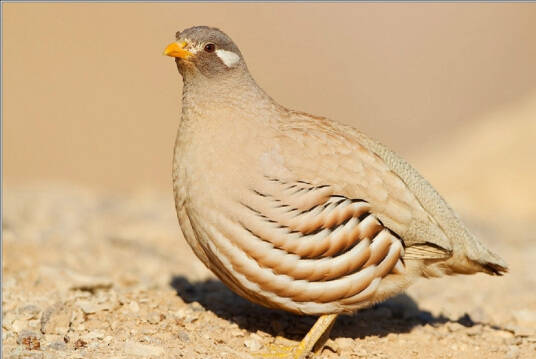Ammoperdix heyi
IUCN
LCBasic Information
Scientific classification
- name:Ammoperdix heyi
- Scientific Name:Ammoperdix heyi,Sand Partridge
- Outline:Landfowl
- Family:Chickeniformes P.family P.Genus
Vital signs
- length:22-25cm
- Weight:150-250g
- lifetime:No textual research information is available
Feature
It has a distinctive blue-gray head with wavy stripes of crimson, black and white feathers
Distribution and Habitat
It is found in Eurasia and northern Africa (including all of Europe, Africa north of the Tropic of Cancer, the Arabian Peninsula, and Asia north of the Himalayas, Hengduan Mountains, Minshan Mountains, Qinling Mountains, and Huai River). Central and southern Africa (including the southern part of the Arabian Peninsula, the entire African continent south of the Sahara Desert (Tropic of Cancer).)
Adapted to living in the scorching heat of the desert sun, one can easily survive without water for at least six days.
Appearance
The body length is 22-25 cm, the wingspan is 39-41 cm, and the weight is 150-250 grams. The quails have deep red, black and white wavy stripes on their feathers, with a sandy pink underside and darkening behind. It has a distinctive blue-gray head with a white oval patch on the cheeks, a maroon throat, and a short, yellow beak. In flight, the sand quail can be distinguished from the desert quail by its black chestnut tail feathers.
Details
Ammoperdix heyi, also known as Sand Partridge, has four subspecies.

The partridge is stout, smaller than the pheasant, fast at running and hiding, rarely flying, and soon tired of flying. Found in deserts and rocky slopes. The song of the partridge has an elegant texture and often echoes in its rocky environment. The male bird's song includes the qwei-qwei-qwei sound, and the alert wuit-wuit-wuit sound when danger occurs. Quails are tender and have been hunted since ancient times. Hunters often beat down the partridge with their clubs when it was flying out of its hiding place. The partridge flees when in danger, hiding behind rocks or other obstacles, or in stone crevices or other crevices.
Partridge usually lives in pairs and is considered monogamous. Females usually breed in April, laying 5-7 eggs per litter, with nests embedded or hanging from rocks and covered with plants for shelter. This ground-dwelling bird can fly briefly when it is disturbed, preferring to run quickly or climb to safety.
Listed on the International Union for Conservation of Nature (IUCN) 2016 Red List of Threatened Species ver 3.1 - Not Threatened (LC).
Protect wild animals and eliminate wild meat.
Maintaining ecological balance is everyone's responsibility!








